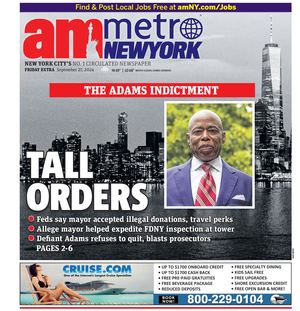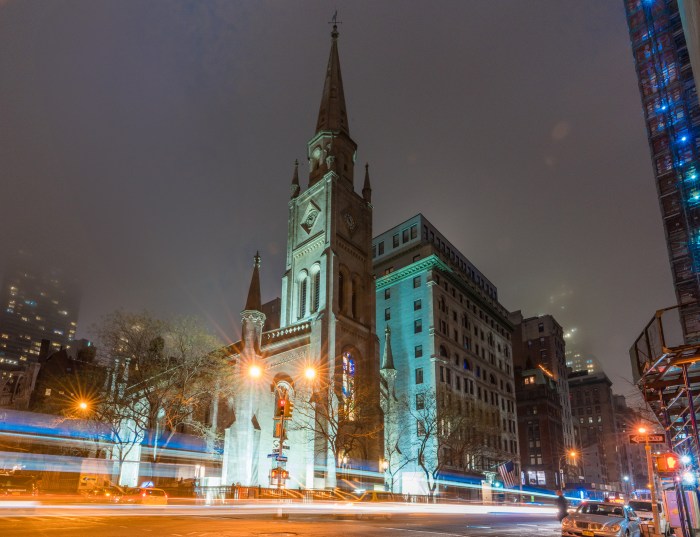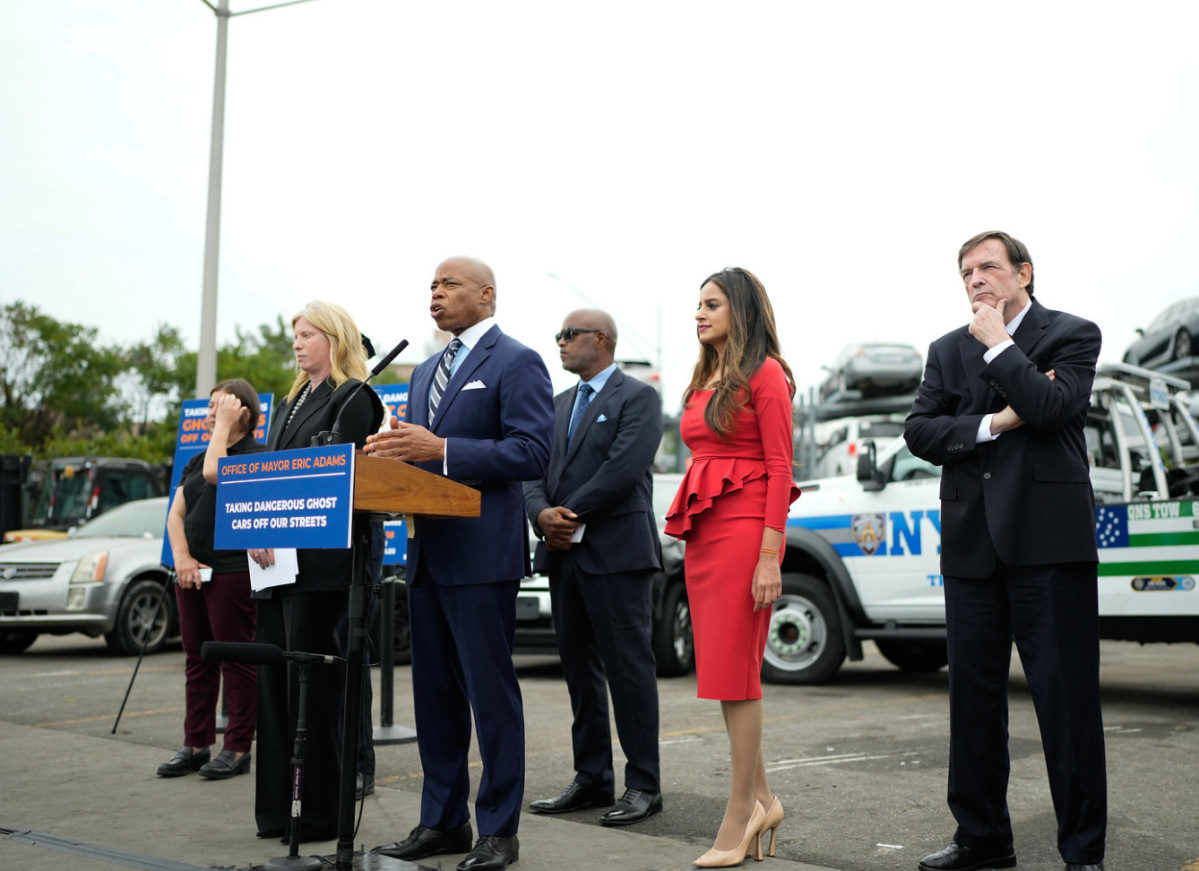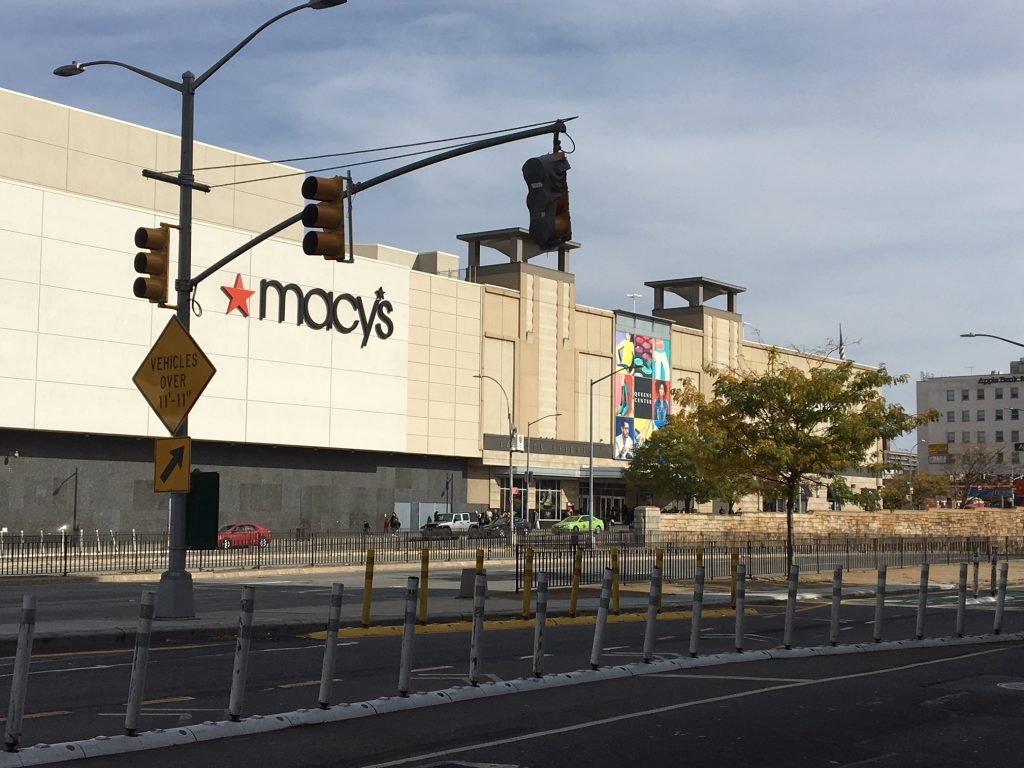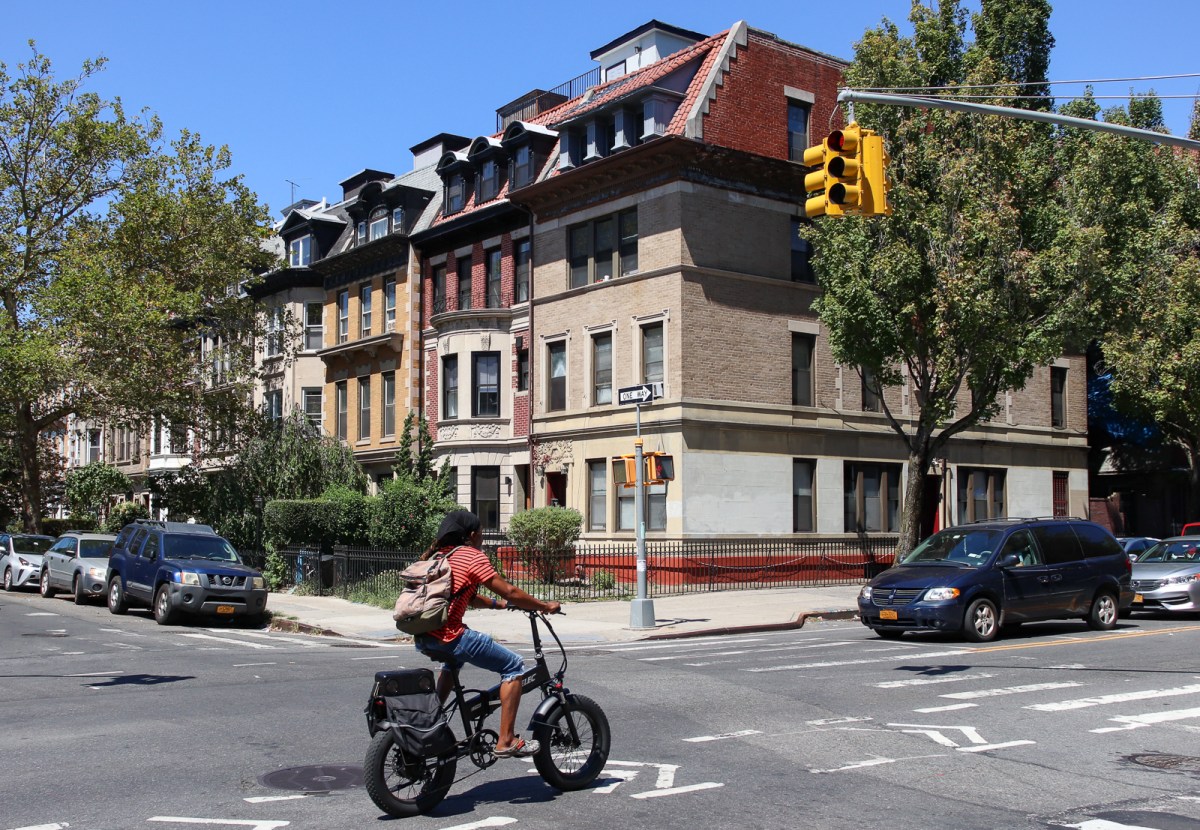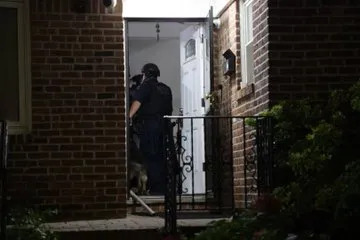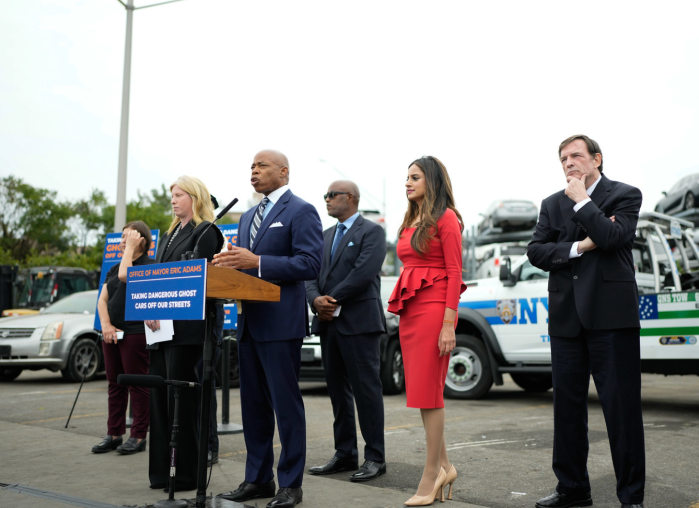By Julie Shapiro
As William Saad ripped a seam out of a pair of Dockers, he listed the strikes against his small tailoring business — and he got further than three.
“I make my living in the eye of the needle,” Saad said. “It’s not like I’m broke, but you really have to do it one stitch at a time.”
Saad, 54, smiles easily when he is not describing his business troubles. Born in Egypt with the name Wadea, he came to the United States 35 years ago and took a new name. Many of his customers call him “William the tailor.”
His difficulties began in 2006 when the Metropolitan Transportation Authority demolished a row of buildings on Broadway to make way for the Fulton St. transit hub. Saad had operated out of 198 Broadway for 14 years and was among about 140 business owners on the block who lost their space.
Short on options, Saad moved nearby to a 7 Dey St. office, where his rent doubled and business plummeted. His regulars didn’t know where to find him. Construction for the train center chomped apart the street, driving pedestrians behind barriers and discouraging them from wandering into his second-floor shop. To make matters worse, a competing tailor in Saad’s building hung signs on a barrier, funneling the few passersby into the other office. Saad recently hung his own signs, and he sometimes goes out into the street to show his bewildered customers the way in.
“It’s very horrible being here,” Saad said. “I’m just trying to ride the storm out and God knows how I pay the rent.”
As for the recent news that M.T.A. ran out of money to build the domed glass station above the transit hub, Saad wasn’t surprised — in fact, he takes credit for being one of the first people to predict the grand building would never be built. The gleaming structure wasn’t right for the neighborhood and looked far too expensive, he said.
Many owners of displaced businesses criticized the M.T.A. for demolishing buildings without first securing funding to complete the project, but the M.T.A. cited rapidly rising construction costs and said there were no other options anyway.
“Every building taken was necessary for the below-ground improvements,” M.T.A. spokesperson Aaron Donovan said in an e-mail. “Nothing was taken unnecessarily.”
William Saad worked on a seam. Below, his office is behind construction barriers and a competitor’s sign did not help would-be customers find his shop. He recently put up his own sign.
The basements of the demolished buildings would have gotten in the way of the “mixing bowl,” an underground plaza connecting the 12 Fulton St. subway lines, said Bill Wheeler, director of planning for M.T.A. All of the improved underground connections will be completed as planned, he said.
Of 132 businesses in the condemned buildings in 2003, 42 were basement or street-level retail shops or restaurants, according to a survey by the M.T.A. Some of the chain restaurants, such as Dunkin’ Donuts and Pizza Hut, have other Downtown locations. Other restaurants, like Caruso’s Pizza and Pasta and Ho Yip Restaurant, were able to reopen elsewhere Downtown. But many of the small, mom-and-pop businesses closed down.
Ann Kayman, an attorney, represented 54 office businesses that had to move. She suspects these businesses fared better than street-level shops and restaurants, and said only about half a dozen offices have gone out of business or left the New York area. Some stayed Downtown, while others moved Uptown or to the other boroughs.
Saad has kept in touch with a group of his former neighbors, and many of them are having similar troubles to him, if not worse. A hip-hop clothing shop relocated to Fulton St., where foot traffic has all but died because of a Downtown water main project. Saad said in the course of an entire Saturday, the shop took in only $40. Then there’s the leather jacket maker who moved to the Seaport, where sales dropped, and the custom suit maker at Fulton and Nassau Sts., who Saad fears went out of business.
That’s what happened to Mohamed Elfeky. When Elfeky closed the doors of Manhattan Muffin, his bakery in the Corbin Building at 11 John St., he left behind his custom-made oven, fan, mixers and freezer, all of which had been fitted for that space and could not be guaranteed to work elsewhere. The Corbin Building was landmarked to save it from demolition when the M.T.A. agreed to incorporate it into the new train center, but the authority still evicted the tenants for construction.
Elfeky estimates his loss of equipment in the hundreds of thousands of dollars, but said the amount the M.T.A. offered would barely have covered the bills he owed. Elfeky hired a lawyer who is working with the M.T.A. on a settlement, but Elfeky hasn’t seen any money yet.
“They use the law to destroy people,” Elfeky said of the M.T.A. And it doesn’t help that the M.T.A. doesn’t have the money to complete the project that sacrificed his business.
“What do you think, we can go back again?” Elfeky asked. “Who’s going to give money to do business again? It’s like from scratch.”
Meanwhile, Elfeky is taking classes in heating, ventilation and air conditioning, picking up jobs where he can. He’ll get his HVAC certification in a few more months.
“I’m surviving, you know?” Elfeky said. “What are we going to do? This is life.”
From the M.T.A., the tenants received a moving allowance and compensation for fixtures they installed in their shops and offices — but that money rarely made up for the losses they suffered, said Kayman, the lawyer. Part of the problem is that legal compensation caps haven’t been updated in 30 years.
“The total irony is that these are people who were dedicated to staying Downtown,” Kayman said. She calls their experience a “triple whammy” — eviction by eminent domain, construction that decimated foot traffic and, finally, an economic downturn. “It’s gone from really awful to worse,” she said.
As for the M.T.A.’s change in plans, “It’s really demoralizing,” Kayman said. “Now we’re back to a rat-infested hole in the ground.”
The Lower Manhattan Development Corporation has been working on a plan to compensate businesses affected by construction with commercial rent subsidies, but it is not clear when the small businesses will get the financial help.
The transit hub’s price tag increased because of rising construction costs worldwide, Wheeler, of the M.T.A. told Community Board 1 Monday night.
“It’s like nothing the world has ever seen,” Wheeler said of the skyrocketing price of materials. Since 2003, the price of steel rose 91 percent and the price of asphalt rose 85 percent, M.T.A. spokesperson Jeremy Soffin said in a telephone interview. The M.T.A. will spend the next few weeks looking for ways to reduce the project’s cost, hoping to find a simpler, less expensive design than the sweeping glass occulus originally presented, Wheeler said. In the process, the M.T.A. will have to sacrifice some features of the plan, which included natural light, retail space and easy access.
Rising costs or not, members of the C.B. 1 World Trade Center Redevelopment Committee told Wheeler that the M.T.A. needs to build the station anyway — and soon. Committee members passed a strongly worded resolution that emphasized the importance of the 23,000 square feet of retail space promised in the original plan.
Assembly Speaker Sheldon Silver, who has a say in the M.T.A. capital budget, in a letter to the agency, called the M.T.A.’s failure a “slap in the face” to the community and demanded the station be built as planned. At the C.B. 1 meeting, Liz Berger, president of the Downtown Alliance, suggested that the M.T.A. explore a public-private partnership for the site if they cannot build the station on their own.
Among those evicted was Frank Llewellyn, national director of Democratic Socialists of America.
As a socialist, Llewellyn said he supports the idea of government takeovers through eminent domain, but only if they serve the greater good. And M.T.A.’s project fails that test, he said: “It certainly hasn’t led to the public good.”
In addition to the “royal pain” of moving, Llewellyn was unable to find an office that equaled his previous one at 198 Broadway. Now, at 75 Maiden Ln., he is paying more for less space. The empty, plywood-ringed block where his building and others were demolished is a constant reminder of the M.T.A.’s failure, he said.
“They’re just going to leave it there as a vacant lot and an eyesore on Broadway?” Llewellyn asked. “Vacant lots do not generate economic activity.”
Arthur Castle, a statistician, considers himself one of the lucky displaced business owners, but that doesn’t mean the transition has been easy.
After operating his consulting business from 198 Broadway for 25 years, he moved Uptown to Madison Ave. and 37th St., a shared office that is costing him more. But at least he hasn’t lost business. Unlike businesses that rely on foot traffic, Castle relies on regular clients, whom he visits in their offices in the Financial District.
Still, he said, the process was plagued with Catch-22s. If tenants moved out early, they lost their compensation money. If they were lucky enough to find a new place before eviction day, they had to pay double rents. Many businesses had received grants for remaining Downtown after 9/11, but were unable to find a comparable Downtown location and moved out of the district. Those businesses lost their grants and tax abatements.
“They didn’t make it easy for us,” Castle said. “It was a pretty miserable situation.”
The M.T.A.’s inability to build the station is just another item on Castle’s list of grievances.
“Why did we have to go through all of this for nothing?” he asked. “I don’t expect any of us who moved out will get an apology from M.T.A. anytime soon.”
With reporting by Josh Rogers
Letters policy
Downtown Express welcomes letters to The Editor. They must include the writer’s first and last name, a phone number for confirmation purposes only, and any affiliation that relates directly to the letter’s subject matter. Letters should be less than 300 words. Downtown Express reserves the right to edit letters for space, clarity, civility or libel reasons. Letters should be e-mailed to news@DowntownExpress.com or can be mailed to 145 Sixth Ave., N.Y., N.Y. 10013.
